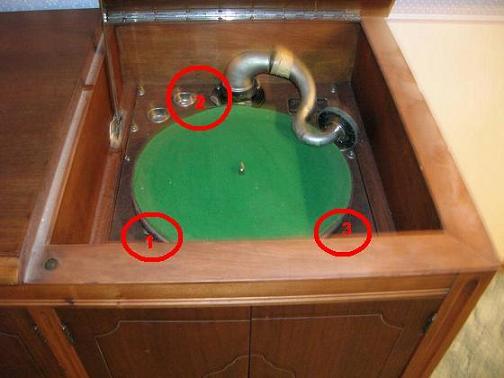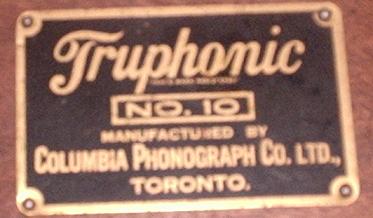This is topic How to operate Gramophone? in forum General Yak at 8mm Forum.
To visit this topic, use this URL:
https://8mmforum.film-tech.com/cgi-bin/ubb/ultimatebb.cgi?ubb=get_topic;f=8;t=001507
Posted by Winbert Hutahaean (Member # 58) on November 27, 2009, 10:24 PM:
As I wrote in other thread, I just bought a Gramophone recently.
This is my first time to have a Gramophone and I think it will be my last. So I don't want to make trouble with it.
Now, I see there are 3 switches near the platter (as picture below).

I believe I understand switch no. 3, it is for speed adjustment (slow or faster).
But what are switch no. 1 and 2 for?
I did play with switch no. 1 by turning right when platter was playing and the platter was stop turning.
I also played with switch no. 2 by turning right, and give the same impact, i.e platter was stop.
So if you guys know what is the purpose for switch no.1 and 2, could you give me an info please.
Secondly, Damien on my other thread told that to change needles every one or two songs. What will be the impact if I use until 4-5 songs?
Lastly, any suggestion about what should not be done with a Gramophone.
thanks,
Posted by Damien Taylor (Member # 1337) on November 27, 2009, 11:29 PM:
Hey Winbert, nice machine. If you could post the manufacturer and even the model I might be able to tell you a bit more about it.
Using the same needle a handful of times all depends on the type of needle, in the past it was often uneconomical to replace the needle so often. However the principle behind changeable needles is that they are made from soft steel that is designed to wear down before the record does. Using the same needle too long will cause the grooves to wear down, and the needle to start shedding pieces in the grooves. They are quite difficult to get out and essentially ruin the records. Different needles also alter the volume of the unit, thin needles are softer, whilst thicker needles make more noise. There were multiple play needles made from tungsten and harder metals, even needles made from cactus thorns and sharpened bamboo.
There are still needles for sale, however for a day to day unit they can be very expensive as they are one side only needles. Perhaps a 78 electric cartridge on a modern turntable would be a more economical solution for daily use.
Posted by Winbert Hutahaean (Member # 58) on November 28, 2009, 05:22 AM:
(ps: I love this forum, any question is answered nicely. I knew I can throw this question in a Gramophone forum somewhere outhere, but then being the first posting usually is hard to get responded)
Damien, the Manufacturer and model no is: Truphonic No. 10 (it was made by Columbia Phonograph).
as the following plaque found in the machine:

I have been googling for this model but only got few infos. Do you have any?
So any answer what the switch no. 1 and 2 are for?
thanks
Posted by Martin Jones (Member # 1163) on November 28, 2009, 05:51 AM:
Most wind-up gramophones (phonographs) had a Speed control which would vary the speed about 78 rpm. This is because not all records were made for 78 rpm exactly (check the writing on the record for the actual speed).
Then, most had a brake, intended mainly (I suspect) for holding the turntable still in transit.
Some were also equipped with an auto-stop mechanism, which could be engaged or dis-engaged with a lever.
3 controls in all.
Needles: Here is a UK source with explanations on needles. But you should be able to find locally (USA/Canada) by Googling Phonograph Needles.
Martin
Posted by Osi Osgood (Member # 424) on November 28, 2009, 09:21 AM:
How to operate a Gramo-phone ...
Yell at Grandma and say ...
"Hey! Grandma! Pick up the phone! It's ringing!"
I know, I'm no help! ![[Big Grin]](biggrin.gif)
Posted by Kurt Gardner (Member # 440) on November 28, 2009, 11:24 PM:
It's strange that there are two brakes on that model. My Victrola only has a speed control and one brake. That's for not only stopping the platter to change the record but saving the "wind" when you've already wound up the spring.
I've used needles for four to five sides and haven't had any adverse reactions. Unless you're going to play the thing for hours every day I don't think that'll be a problem. And when not in use, I leave the spring "unwound" with no tension by letting the platter spin until it runs out. I just think if you leave the spring tense it will eventually break.
Incidentally, during the Northridge, California earthquake of 1994, my Victrola was hurled across the room and not only survived, it sustained virtually no damage!
Visit www.film-tech.com for free equipment manual downloads. Copyright 2003-2019 Film-Tech Cinema Systems LLC

UBB.classicTM
6.3.1.2
![[Big Grin]](biggrin.gif)